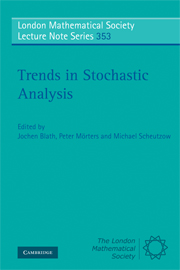Refine search
Actions for selected content:
3023 results in Probability theory and stochastic processes
3 - Stein's method for one-dimensional normal approximations
-
- Book:
- Normal Approximations with Malliavin Calculus
- Published online:
- 05 June 2012
- Print publication:
- 10 May 2012, pp 59-78
-
- Chapter
- Export citation
1 - Malliavin operators in the one-dimensional case
-
- Book:
- Normal Approximations with Malliavin Calculus
- Published online:
- 05 June 2012
- Print publication:
- 10 May 2012, pp 4-21
-
- Chapter
- Export citation
Frontmatter
-
- Book:
- Normal Approximations with Malliavin Calculus
- Published online:
- 05 June 2012
- Print publication:
- 10 May 2012, pp i-vi
-
- Chapter
- Export citation
Contents
-
- Book:
- Normal Approximations with Malliavin Calculus
- Published online:
- 05 June 2012
- Print publication:
- 10 May 2012, pp vii-x
-
- Chapter
- Export citation
9 - Exact asymptotics and optimal rates
-
- Book:
- Normal Approximations with Malliavin Calculus
- Published online:
- 05 June 2012
- Print publication:
- 10 May 2012, pp 160-169
-
- Chapter
- Export citation
6 - Multivariate normal approximations
-
- Book:
- Normal Approximations with Malliavin Calculus
- Published online:
- 05 June 2012
- Print publication:
- 10 May 2012, pp 116-127
-
- Chapter
- Export citation
Preface
-
- Book:
- Normal Approximations with Malliavin Calculus
- Published online:
- 05 June 2012
- Print publication:
- 10 May 2012, pp xi-xiv
-
- Chapter
- Export citation
References
-
- Book:
- Normal Approximations with Malliavin Calculus
- Published online:
- 05 June 2012
- Print publication:
- 10 May 2012, pp 227-234
-
- Chapter
- Export citation
Notation index
-
- Book:
- Normal Approximations with Malliavin Calculus
- Published online:
- 05 June 2012
- Print publication:
- 10 May 2012, pp 237-237
-
- Chapter
- Export citation
7 - Exploring the Breuer–Major theorem
-
- Book:
- Normal Approximations with Malliavin Calculus
- Published online:
- 05 June 2012
- Print publication:
- 10 May 2012, pp 128-147
-
- Chapter
- Export citation
Appendix A - Gaussian elements, cumulants and Edgeworth expansions
-
- Book:
- Normal Approximations with Malliavin Calculus
- Published online:
- 05 June 2012
- Print publication:
- 10 May 2012, pp 197-204
-
- Chapter
- Export citation
10 - Density estimates
-
- Book:
- Normal Approximations with Malliavin Calculus
- Published online:
- 05 June 2012
- Print publication:
- 10 May 2012, pp 170-178
-
- Chapter
- Export citation
Appendix B - Hilbert space notation
-
- Book:
- Normal Approximations with Malliavin Calculus
- Published online:
- 05 June 2012
- Print publication:
- 10 May 2012, pp 205-208
-
- Chapter
- Export citation
Subject index
-
- Book:
- Normal Approximations with Malliavin Calculus
- Published online:
- 05 June 2012
- Print publication:
- 10 May 2012, pp 238-239
-
- Chapter
- Export citation
Author index
-
- Book:
- Normal Approximations with Malliavin Calculus
- Published online:
- 05 June 2012
- Print publication:
- 10 May 2012, pp 235-236
-
- Chapter
- Export citation
2 - Malliavin operators and isonormal Gaussian processes
-
- Book:
- Normal Approximations with Malliavin Calculus
- Published online:
- 05 June 2012
- Print publication:
- 10 May 2012, pp 22-58
-
- Chapter
- Export citation
8 - Computation of cumulants
-
- Book:
- Normal Approximations with Malliavin Calculus
- Published online:
- 05 June 2012
- Print publication:
- 10 May 2012, pp 148-159
-
- Chapter
- Export citation
Appendix D - Fractional Brownian motion
-
- Book:
- Normal Approximations with Malliavin Calculus
- Published online:
- 05 June 2012
- Print publication:
- 10 May 2012, pp 215-224
-
- Chapter
- Export citation

Trends in Stochastic Analysis
-
- Published online:
- 05 March 2012
- Print publication:
- 09 April 2009

Malliavin Calculus for Lévy Processes and Infinite-Dimensional Brownian Motion
-
- Published online:
- 05 March 2012
- Print publication:
- 01 March 2012
